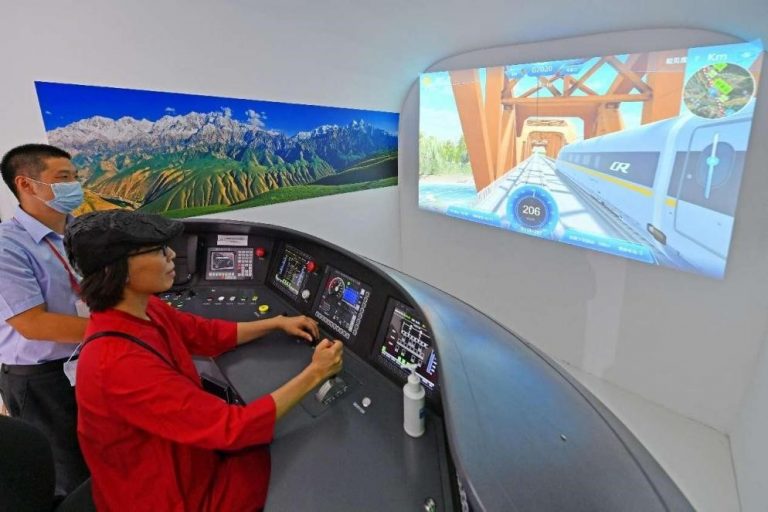
By Li Xinping, On Sept. 24, 1909, the Beijing-Zhangjiakou Railway, designed by Zhan Tianyou, known as the “father of China’s railroad,” was officially completed. It was the first trunk railway in China that was independently designed and constructed by Chinese.
In commemoration of the railroad engineer, a statue of him has been erected beside the Qinglongqiao Station of the Beijing-Zhangjiakou Railway, which sits at the foot of the Great Wall in Yanqing, Beijing.
On Dec. 30, 2019, the Beijing-Zhangjiakou High-Speed Railway went into operation. Equipped with an autopilot system, it is the world’s first smart high-speed railway with a designed speed of 350 kilometers per hour..
From constituting China’s first iron road to becoming the world’s most advanced railway, and lifting the speed from 35 kilometers per hour to 350 kilometers per hour, the rail tracks linking Beijing and Zhangjiakou are a witness to not only China’s railway development, but also the giant leap of the country’s comprehensive strength in a century.
“Thanks to the autopilot system, Fuxing bullet trains boast a stopping accuracy within 10 centimeters from braking to a complete halt,” said Wang Haitao, head of the Beijing-Zhangjiakou train team of the Huairou North Locomotive Depot, China Railway Beijing Group.
The Beijing-Zhangjiakou High-Speed Railway is a hallmark of China’s advanced manufacturing. Leveraging the Beidou Navigation Satellite System (BDS) and geography information system, managers of the railway can monitor every bridge, track section, and roadbed along the entire line around the clock, enabling seamless operations, scheduling, maintenance, and emergency response. Whether it’s component wear, roadbed settlement, or signal failures, everything is under precise control.
A Fuxing bullet train is equipped with over 2,000 monitoring points, providing comprehensive self-monitoring for intelligent operations. Supported by the BDS, the train automatically calculates optimal driving strategies based on terrain and track conditions, adjusting speed smoothly for a seamless ride from start to finish.
The International Union of Railways praised the Beijing-Zhangjiakou High-Speed Railway, calling it an outstanding example of artificial intelligence implementation in the railway industry to date.
To build itself into an intelligent railway, the Beijing-Zhangjiakou High-Speed Railway carried out 67 specialized research projects in intelligent technology, becoming the first in the world to implement fully integrated 3D intelligent collaborative design across the entire line, all disciplines, and every stage of the project.
“We began by generating a geographic twin model using data from early exploration and surveying, then incorporated our independently developed intelligent algorithms for route selection and engineering design,” said Lyu Gang, deputy chief engineer at China Railway Engineering Design and Consulting Group Co., Ltd.
Thanks to the 3D intelligent collaborative design, the efficiency and accuracy of route planning were significantly improved. The resulting digital twin model not only enabled precise construction management but also provided a digital archive to support intelligent operations, Lyu explained.
“One moment, you’re surrounded by skyscrapers; the next, you’re underground,” said a passenger as a train quickly entered the Qinghuayuan tunnel shortly after departing Beijing North Railway Station.
This tunnel intersects with Beijing Metro Lines 10, 15, and 12, runs parallel for a long stretch with Line 13, and passes beneath seven major urban roads and over 100 critical municipal pipelines.
It was with the help of intelligent construction technologies that this complexity was managed – constructors used an advanced slurry balance shield tunneling machine and established a cloud-based intelligent tunneling visualization platform.
“This is like equipping the shield tunneling machine with a ‘heavenly eye,’ allowing us to monitor deformations in the tunnel and surrounding structures in real-time,” said Zhao Bin, shield tunneling manager for the Qinghuayuan tunnel from China Railway 14th Bureau Group Co., Ltd., a subsidiary of the China Railway Construction Corporation. This approach significantly enhanced construction precision, keeping settlement errors within 2 millimeters.
“The Beijing-Zhangjiakou High-Speed Railway represents the first integrated application of China’s latest intelligent railway innovations, marking the beginning of a new era for smart railways in the country,” said Li Ping, chief researcher at China Academy of Railway Sciences Corporation Limited.
“In recent years, the technological achievements of the Beijing-Zhangjiakou Railway have been gradually applied to major projects such as the Beijing-Xiong’an intercity railway, the Fuzhou-Xiamen High-Speed Railway, and Indonesia’s Jakarta-Bandung High-Speed Railway,” said Chen Yuan, deputy director of the standards division under the science and information department at China State Railway Group Co., Ltd.
“Building on the foundation of the Beijing-Zhangjiakou High-Speed Railway, we have developed an intelligent high-speed railway technology system that has been adopted by the UIC, offering a Chinese solution for global smart railway development,” Chen added.










